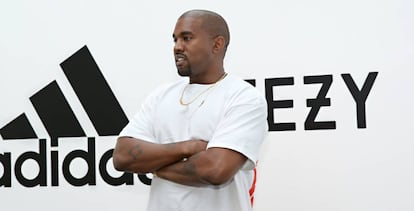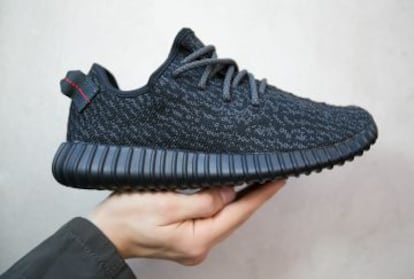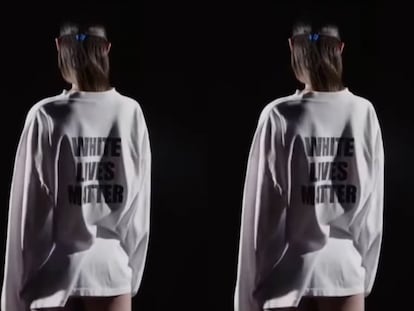After the fall of Kanye West, Adidas is trying to figure out what to do with $1.2 billion in unsellable products
The rupture between the sports company and the musician has ended a golden age for ‘streetwear’ culture. The business is now facing a dilemma regarding what will happen to Yeezy, the Kanye-owned brand they have been promoting since 2015

On October 25, one of the most lucrative urban fashion alliances in recent years officially came to an end.
Through a statement, Adidas announced the immediate end of its collaboration with Kanye West (now named Ye) and their joint brand, Yeezy. This was the sportswear giant’s reaction to the antisemitic remarks made by the American rapper and businessman – just one of his many controversial episodes.
The urban fashion partnership – which began in 2015 and put Adidas at the forefront of “streetwear” culture – is now over. However, there are still many issues that need to be resolved.
The heritage of the Adidas-West collaboration is not only symbolic, but also material. This month, the firm estimated that by not putting up its stock of Yeezy products for sale, it will lose $1.2 billion – a major hit on the company’s finances, reportedly representing about 10% of annual revenue. How Adidas will manage its future is now a mystery. The same goes for the urban fashion community, with one of its iconic brands in deep trouble.
Kanye West’s arrival to Adidas in 2015 was an earthquake in the urban fashion industry – a sector that is estimated to generate about $173 billion in global sales per year. At the height of his popularity, the rapper had released two sneaker models alongside Nike. But West wanted more: total creative control and his own clothing line.
Nike’s refusal to grant him those powers led the artist to knock on the door of rival firm Adidas. Management had noticed how Nike was ahead of them in the urban fashion sector, thanks to the Jordan brand. They promptly accepted Kanye’s offer, thus giving birth to Yeezy: a name that sparked madness among an increasingly fashion-conscious public, thanks to West’s visionary designs.

“The signing of Kanye West by Adidas changed the game – that’s where the madness began,” explains Ernesto Cabeza, a sneakers collector.
“Before, there was resale and there were many [shoe] models that were hard to find… but with Yeezy came the boom. They were the first shoes that were already [being resold] as soon as they came out. You could pay between $1,000 and $2,000 for some models.”
Limited editions – which fed the desire for exclusivity – entered a new phase, in which the resale market skyrocketed. A whole movement suddenly surrounded each launch (or “drop”); a ritual in the form of a challenge to get ahold of the latest shoe model.
“West’s arrival at Adidas made the company recover ground that it had lost,” confirms Kike Marina, a sneaker specialist and the creator of the first Spanish-language blog about them: sz9.
“It was a series of small successes that came at a time when streetwear was beginning to become something close to luxury. Adidas had already collaborated with Yohji Yamamoto on Y-3, for example. But over time, they had lost the image that was associated with the word ‘premium.’”
The alliance set the pace for streetwear from 2015 to the end of the last decade, even as Yeezy-branded products became more accessible.
“Adidas saw the formula and burned it,” says Cabeza. “Models like the 350 v2 came out in 80 or 90 colors. Even so, some pairs kept selling out.”
“It’s a process that had been designed like this from the beginning,” affirms Marina. “Creating difficulty to access a product is the easiest part… many people have succeeded in doing that. The problem is when you turn your product into something massive and you want to maintain that spirit. Yeezy knew how to do it. More than the product itself, the success was the way to stagger its access: [the supply] was always a little less than what people wanted. In this way, [Adidas] was able to create expectations for the next release.”
Like any other market, the streetwear market is based on supply and demand. However, for this particular sector, the most reliable index is resale. The Stockx website – which shows the evolution of the prices of the most sought-after sneaker models – indicates that Yeezies continue to be priced as they were before the split between West and Adidas. However, different questions arise for the brand… all of them quite costly.

“The numbers speak for themselves: we’re not getting the results we should be,” Bjørn Gulden – the new CEO of Adidas – recently declared. He has arrived at the company fresh from another rival: Puma.
“2023 is going to be a year of transition, to set the base to again be a growing and profitable company.” Adidas has “all the ingredients to be successful,” Gulden stressed, but just needs “some time” to rebuild.
West’s controversies had a large impact on the fall in the Adidas stock price. It remains to be seen what the company will do with the remaining stock of Yeezy products.
“I don’t think destroying these products is an option. No company in 2023 can justify a practice that is already beginning to be legislated in countries like France. It would be an even bigger reputational disaster,” says Marina.
One of the options being considered by the streetwear community is for these products to go on sale without ties to the Yeezy label… although this strategy could also have negative implications.
“If you want to disassociate yourself from Yeezy and put those products on sale, even if they don’t carry the brand name, it would be showing a tremendous double standard,” opines Cabeza.
Beyond imaginative solutions such as those proposed in an article for The Guardian (“melt them down and turn them into crocs?”), the key may lie in allowing a reasonable amount of time to pass.
“Brands have a short memory in this regard,” Marina notes. “There are athletes who have suffered problems of this type before. I’m thinking, for example, of Manny Pacquiao and his homophobic statements, or Kobe Bryant, who signed a [non-disclusure] agreement to avoid a trial for rape and continued to be the image of Nike. Sports brands often target a very young consumer, who thinks in the moment and doesn’t research what happened three years ago.”
Another example of how the public image of a brand or a designer can be renewed can be found in the case of John Galliano. As with West, anti-Semitic remarks led to his dismissal from Dior. However, three years later, he became creative director of Maison Margiela.
While waiting to find out what the brand will have in store, Yeezy’s paradox is that it continues to maintain its market value.
“Kanye West has always been controversial. Love him or hate him, but I think his persona is separate from the Yeezy models,” concludes Cabeza. “In fact, there are models that may be worth more now that they’re out of Adidas.”
Sign up for our weekly newsletter to get more English-language news coverage from EL PAÍS USA Edition
Tu suscripción se está usando en otro dispositivo
¿Quieres añadir otro usuario a tu suscripción?
Si continúas leyendo en este dispositivo, no se podrá leer en el otro.
FlechaTu suscripción se está usando en otro dispositivo y solo puedes acceder a EL PAÍS desde un dispositivo a la vez.
Si quieres compartir tu cuenta, cambia tu suscripción a la modalidad Premium, así podrás añadir otro usuario. Cada uno accederá con su propia cuenta de email, lo que os permitirá personalizar vuestra experiencia en EL PAÍS.
¿Tienes una suscripción de empresa? Accede aquí para contratar más cuentas.
En el caso de no saber quién está usando tu cuenta, te recomendamos cambiar tu contraseña aquí.
Si decides continuar compartiendo tu cuenta, este mensaje se mostrará en tu dispositivo y en el de la otra persona que está usando tu cuenta de forma indefinida, afectando a tu experiencia de lectura. Puedes consultar aquí los términos y condiciones de la suscripción digital.
More information
Archived In
Últimas noticias
Welcome to the post-religion era: The idea of Christianity as the absolute truth has become obsolete
‘I thought you would like it’: The risky sexual practice popularized by TV shows and TikTok
The digitalization of tourism: ‘They promise experiences and gave us the worst possible one’
Mexican peso defies uncertainty with forecasts of a new period of stability in 2026
Most viewed
- Sinaloa Cartel war is taking its toll on Los Chapitos
- Oona Chaplin: ‘I told James Cameron that I was living in a treehouse and starting a permaculture project with a friend’
- Reinhard Genzel, Nobel laureate in physics: ‘One-minute videos will never give you the truth’
- Why the price of coffee has skyrocketed: from Brazilian plantations to specialty coffee houses
- Silver prices are going crazy: This is what’s fueling the rally










































